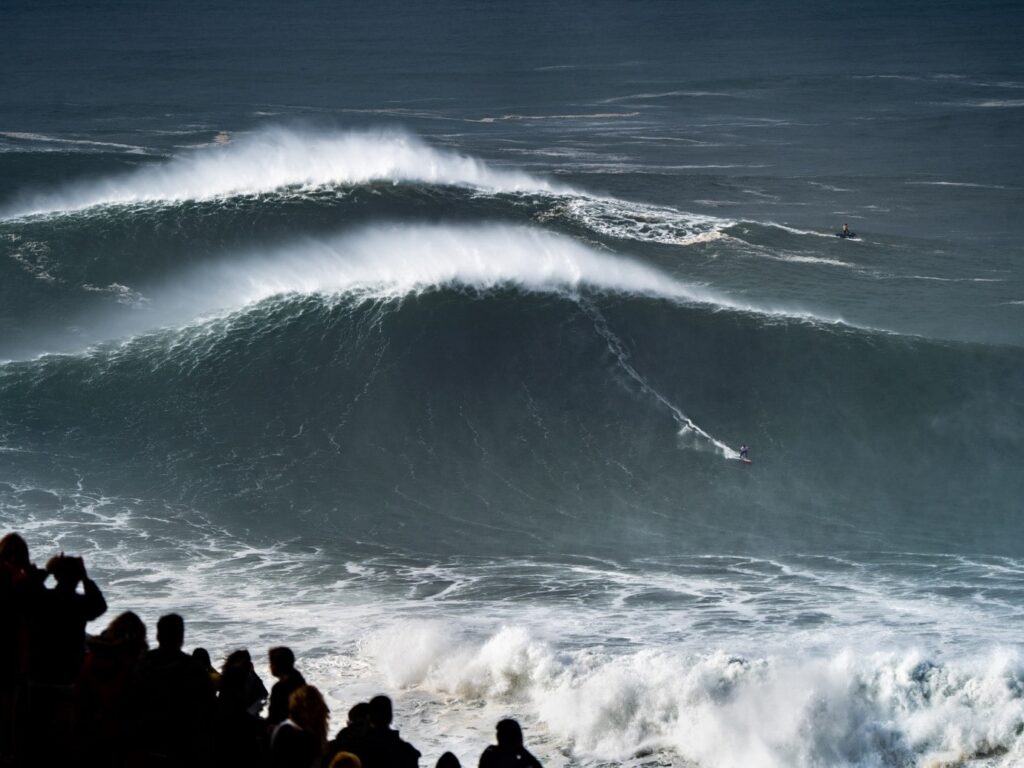At AllWaves, we have the knowledge & technology to create any wave we like. In doing so, we are inspired by nature. In this series, we will explain how the world’s most famous waves such as as Praia do Norte, Nazaré came to be. This time, we explain the waves at Nazaré. By understanding the science behind the (water)curtain, we can create our own custom waves in our wavepool. In conclusion: read further if you want to look smart to your friends.
Location
Nazaré is uniquely situated at the center of the coastline of Portugal, Europe. Facing the Atlantic. From the legendary lighthouse, you can see the spectacle from up close. It is built on the fort of Sao Miguel Arcanjo. The primitive fort was initially constructed in the 16th century with the intention of defending the trading activities of Nazaré from attacks by pirates. “Fun” fact: beneath the surface also lies a German submarine U-963, which was purposely sunk in Nazaré’s waters at the end of World War II because it is so deep. Since the years 2000 (yes, only “recently”), it’s attracting big wave surfers from all over the world. It is home to many big wave contests. Which boost the local economy. More on that later in a separate blog on “surfonomics“.
Today, the World Surf League holds an annual big wave event at Nazaré during winter months. And when we mean big, we mean huge. The current world record stands at 26.21 meters ( 86-foot wave) on the name of a German (!) surfer Sebastian Steudtner in 2020. This is of course not the size of waves we aim for at a wavepool. But, we can learn a lot by studying the wave at Nazaré.
Bathymetry of Nazaré
The reason the waves in Nazaré get so big is not by coincidence. It is because what lies beneath… The wave at Nazara Praia do Norte is in fact not one wave, but two waves. You will understand more clearly if you take a closer look at the the ocean floor shape a.k.a. bathymetry of the Nazaré canyon. It is the largest submarine canyon in Europe, reaching depths of about 5 km deep (16,000 ft) and a length of about 230 kilometres (140 mi). Next to that, the Grand Canyon in the USA, fades away.
Refraction
We explained “refraction” in a previous post on Skeleton Bay. Refraction also occurs in underwater canyons. The canyon refracts the wave into two waves with uneven speeds. Because of the orientation of the canyon, the refraction interferes with one another, forming a square pattern. As you see on the picture below, “X” marks the spot where the two waves collide.

This short video from the WSL explains the dynamics of the canyon very well.
What is a wedge
The refrection creates a “wedge”, or collision of two waves, forming a new wave which is larger than both waves combined. Another word added to your surf dictionary.
Add to that, backwash, water moving via the canyon back into the direction of the ocean, and you get an additional “lift” in the wave. In the picture below you can clearly see this creates a particular shape, “peak” wave. The lips are thick and don’t break right away, the face is almost a straight drop, the barrels are often tight and close out quickly.

A similar phenomenon happens in “The Wedge” in California. However, the refraction is caused by a reflection of the wave off the jetty. The resulting wave is a lot smaller and more suited for bodyboarders than tow-in surfers.
Season
The big wave season is in winter. With big winter swell in the North-Atlantic start in October and continue until late March. Therefore, most competitions are held then.
Conclusion
To surf a wave at Nazaré requires lots of guts & an entire jet ski team to help you in & out of the water in case of wipe-outs. Only reserved for big wave surfers and pro’s with the necessary resources to fund such an adventure. In conclusion, we would suggest surfing a wavepool, to keep it smaller, safer & much cheaper than traveling to Nazaré😉.
To learn everything about Nazaré’s surfing history, check out this documentary: 100 Foot Wave. It follows the decade-long odyssey of big-wave pioneer Garrett McNamara in Nazaré.
So what’s in it for AllWaves?
At AllWaves, we are inspired by these creations & forces of nature. Therefore, we made sure we can pre-condition waves with our proprietary algorithm & wavemaker. This means we cannot only choose height, but also speed AND shape. We’ll experiment with refraction too, sending waves of different speeds & directions through the pillow in order to create very nice variations of waves.
This results in endless combinations and really the possibility to create “all waves” for all surfers. That’s the reason we call our employees “waveshapers”.
Hope you enjoyed our read,
Keep surfing!
Sources used:
https://en.wikipedia.org/wiki/Nazar%C3%A9_Canyon
https://pvelasco.myportfolio.com/nazare-canyon
https://www.surfertoday.com/surfing/the-mechanics-of-the-nazare-canyon-wave



